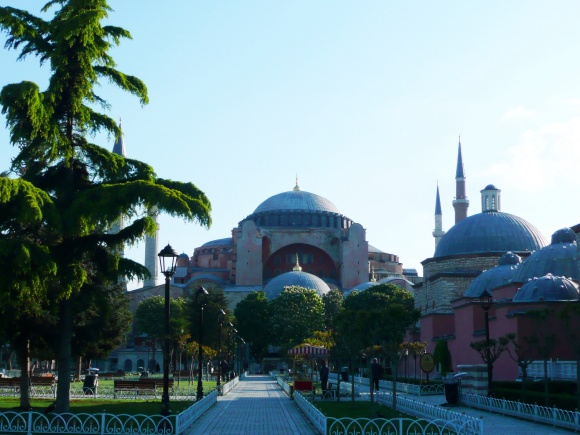“Byzantium, Byzantium, Constantinople, Kostaniniyye, Istanbul – The City has tangled with or represented an “idea” for so many, its influence has spun so far that her story, whether imperial, spiritual, cultural or political, frequently ends up being played out anywhere and everywhere other than in the city itself”. Bethany Hughes , Istanbul – A Tale of Three Cities
As we observe Turkish president Recep Tayyib Erdogan’s apparent drive to reestablish Ottoman autocracy, those who take a longer view of history will assert that there is nothing new under the sun. There is nothing unprecedented about Erdogan’s apparent urge to don the imperial purple, and join the long cavalcade of colourful emperors and sultans that ruled the land that now constitute modern Turkey.
Richard Fidler reminds of this as he literally walks us through the streets of Istanbul.
Part father-son quest, part travel story, ‘Ghost Empire’ is at once a history, and a treasury of tales both true and far-fetched. The Australian author and broadcaster, and onetime member of the comedy trio, the Doug Anthony Allstars, has written a blend of popular history and meditation on the significance of history.
Although ‘Ghost Empire’ might in seem in parts overly breezy and lightweight, as an introduction to the ancient and wondrous city of Byzantium/Constantinople/Istanbul, it is an highly informative portal to weightier albeit less entertaining books. This is not to say it is without its more harrowing moments. Fidler dwells as much on the gory as on the glory. And indeed, for many, particularly the sons of emperors and sultans, confidants and conspirators, life could indeed be nasty, brutish and short.
Whilst Fidler’s primary focus is the story of the Byzantines, concluding with the fall of Constantinople in 1453, he travels back and forth in Istanbul’s long and storied history, between the violent past and the tumultuous present, from Julius Caesar and Constantine the Great, and the power couple Justinian and Theodosia, through Mehmet the Conqueror and Suleiman the Magnificent, to Ataturk and Erdogan, and captures the magic and at times, mayhem of the fabled metropolis that inspired WB Yeats to write:
“Once out of nature I shall never take
My bodily form from any natural thing,
But such a form as Grecian goldsmiths make
Of hammered gold and gold enamelling
To keep a drowsy Emperor awake;
Or set upon a golden bough to sing
To lords and ladies of Byzantium
Of what is past, or passing, or to come”
© Paul Hemphill 2017. All rights reserved
If Ghost Empire has whetted you appetite, i would recommend Bethany Hughes’ more substantial – “encyclopedic ” would a better description – Istanbul – A Tale of Three Cities (Orion 2017). It is a lengthy, comprehensive and fascinating journey from the prehistoric past to the polarizing present.
There is also Simon Sebag Montefiore’s documentary, which personally, I found disappointing after his Jerusalem – The Biography.
For other posts about Turkey in In That Howling Infinite, see: People watching in Sultanahmet, Ottoman Redux – an alternative history and The Watchers of the Water
Here are some reviews of Ghost Empire:
 Istanbul, from Galata Tower
Istanbul, from Galata Tower Cruising the Golden Horn
Cruising the Golden Horn The Sulaymaniya Mosque
The Sulaymaniya Mosque Aya Sofya
Aya Sofya The Hippodrome and the Blue Mosque
The Hippodrome and the Blue Mosque The Fortress of Europe
The Fortress of Europe Valen’s Aqueduct
Valen’s Aqueduct Galata Tower
Galata Tower Aya Sofya
Aya Sofya Aya Sofya
Aya Sofya Aya Sofya
Aya Sofya Aya Sofya
Aya Sofya Halfden the Viking’s Grafitti in Aya Sofya
Halfden the Viking’s Grafitti in Aya Sofya Aya Sofya
Aya Sofya Aya Sofya
Aya Sofya Sulaymaniya
Sulaymaniya Justinian’s Cistern
Justinian’s Cistern Apollo and Medusa
Apollo and Medusa


